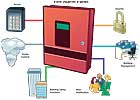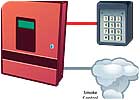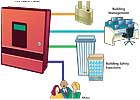
Although there is a lot of talk about integrated fire alarm systems today, this is not a new concept. I installed my first integrated fire alarm system back in 1984. Today’s advanced technology, however, does allow for more integration with other types of systems than ever before.
Fire alarms can integrate with many other systems, but the most common is integration with security systems. They can also be integrated with building management systems, smoke control systems, suppression systems or even something as simple as using the fire alarm emergency voice communications system for other purposes like paging or background music.

A DEGREE OF INTEGRATION
Most fire alarm systems are integrated systems to a certain extent. They are used to monitor sprinkler systems, shut down air handler units, close smoke doors, recall elevators and control smoke dampers for smoke control systems. Some fire alarms are cross-listed as suppression systems for use in locations such as computer rooms.NFPA 72, in paragraph 6.8.2.1 states, “Fire alarm systems shall be permitted to be either integrated systems combining all detection, notification, and auxiliary functions in a single system, or a combination of component subsystems. Fire alarm system components shall be permitted to share control equipment or shall be able to operate as stand-alone subsystems, but, in any case, they shall be arranged to function as a single system.”
For the first time, in the 2007 NFPA 72, National Fire Alarm Code, there is new information on utilizing fire alarm systems with mass notification systems. These systems are used to notify people of other potential emergencies, such as terrorist attacks or tornadoes. Such systems may be used in only one building or they may be used campus-wide on military bases, university campuses, industrial complexes or even towns.
FIRE AND SECURITY
A combination fire alarm and security system is one of the most common applications for an integrated fire alarm system. These systems are very common in homes and small businesses. In this case, the systems must be listed for both uses, and fire alarms always take the highest priority – even if the other system operates first. The only exception to this is with mass notification systems. Those signals may take a higher priority in certain situations.EXPANDING CONTROL
Fire alarm systems can be interconnected with other controls as well, including for non-emergency purposes. NFPA 72 allows fire alarm speakers to be used for non-emergency purposes under certain conditions. One of the most common applications is to allow the fire alarm voice communications systems to be used for paging purposes.Fire alarm speakers also can be used for background music, provided that “the speakers and associated audio equipment are installed or located with safeguards to prevent tampering or maladjustment of those components essential to intended operation for fire.” In addition, the speaker wiring has to remain monitored for integrity while the non-emergency system is in use. Of course, you are only allowed to use fire alarm speakers for other purposes if allowed by the Authority Having Jurisdiction (AHJ).
When interconnecting a fire alarm system with other controls, installers can connect them by either using relay contacts or data communications gateways. NFPA 72 allows “other listed methods” as well to allow for future technologies. All the interconnection wiring must be monitored for integrity and be installed per the National Electrical Code. Each interconnected control unit must be separately monitored for alarm, supervisory and trouble signals. In addition, the other systems cannot interfere with the operation of the fire alarm, and any fault on the other system cannot affect the required operation of the fire alarm system, including the monitoring for integrity of the fire alarm circuits.
INTEGRATING WITH ACCESS
With higher security concerns in today’s environment, fire alarm systems may be interconnected with access control systems. Newer technology now allows manufacturers to provide access control functions over the same signaling line circuits connecting the fire alarm devices using the same power supplies.
ALL THINGS LOW VOLTAGE
In today’s competitive market, customers prefer to have one contractor do all the low-voltage work rather than having multiple contractors individually perform each job. This not only saves money, but also makes for more reliable operations of these systems. Doing this with a single system instead of multiple systems make sense. Some AHJs still prefer having a separate fire alarm system rather than having all your eggs in one basket, but technology has advanced to a level that provides a much higher level of confidence in the successful operation of all systems that this “old school” thinking is going away.The National Electrical Code (NEC) sets the requirements for all wiring. Article 760 is used for fire alarm wiring and includes requirements for what other conductors fire alarm circuits can be installed with. Article 725 is used for many other related circuits such as security wiring and building fire safety function wiring. Article 760 does not allow power-limited fire alarm circuits – which include most of the fire alarm circuits installed – to be installed with power and light wiring or nonpower-limited wiring. You can install security circuits with fire alarm circuits as long as the security wiring meets the requirements of the fire alarm wiring. You can also install communications conductors with fire alarm power-limited.
When installing an integrated system, keep in mind what must be included in the battery calculations. NFPA 72 states that any device that receives its power from the control unit while the system is running on standby power must be included in the battery calculations. This is important to ensure that the fire alarm system will operate for its required standby time of 24 hours and alarm time of five minutes.
TESTING
When testing integrated systems, you must ensure that everything works as intended. If multiple types of systems use a common control, the non-fire-alarm devices must be tested to make sure that the fire alarm has the highest priority and that they do not interfere with the fire alarm operation. NFPA 72, Chapter 10 addresses testing and inspection requirements of the fire alarm components and fire safety function interfaces, but it has no jurisdiction over non-fire-alarm components.Integrating systems also means that the installers and service personnel must be more qualified than ever before—on the fire alarm system, and all the systems that are part of the integrated system. NFPA 72 sets guidelines for qualifications for designers, installers and service personnel. Factory training on this equipment is essential, as well as having a much broader knowledge of the codes involved. Installers will need to get familiar with more of the building and fire codes. Unfortunately, not all of these requirements are found in the same places as fire alarm requirements are found, so additional training on the codes is essential. NFPA now has two new security documents that need to be learned in addition to the building, fire, fire alarm and mechanical codes. NFPA 730 is the Guide for Premises Security and addresses construction, protection and occupancy features from residential dwellings to large industrial complexes. NFPA 731 is the Standard for Installation of Electronic Premises Security Systems and covers requirements for installation of all types of security systems. Copies are available atwww.nfpa.org.
Regardless of the type of system you plan to install, make sure you know the code requirements for that system. When dealing with life safety systems, it is important to make these systems as reliable as possible.